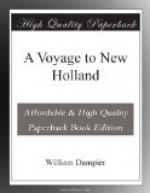And afterwards, steering east by south purposely to
avoid it, I thought I must have been to the south
of it: but sounding again at 1 o’clock in
the morning August the first, we had but 25 fathom,
coral rocks; and so found the shoal was to the south
of us. We presently tacked again, and stood to
the north, and then soon deepened our water; for at
2 in the morning we had 26 fathom coral still:
at 3 we had 28 coral ground: at 4 we had 30 fathom,
coarse sand, with some coral: at 5 we had 45
fathom, coarse sand and shells; being now off the
shoal, as appeared by the sand and shells, and by
having left the coral. By all this I knew we had
fallen into the north of the shoal, and that it was
laid down wrong in my sea-chart: for I found
it lie in about 27 degrees latitude, and by our run
in the next day I found that the outward edge of it,
which I sounded on, lies 16 leagues off shore.
When it was day we steered in east-north-east with
a fine brisk gale; but did not see the land till 9
in the morning, when we saw it from our topmast-head,
and were distant from it about 10 leagues; having
then 40 fathom water, and clean sand. About 3
hours after we saw it on our quarter-deck, being by
judgment about 6 leagues off, and we had then 40 fathom,
clean sand. As we ran in this day and the next
we took several sights of it, at different bearings
and distances; from which it appeared as you see.
And here I would note once for all that the latitudes
marked in the draughts, or sights here given, are not
the latitude of the land, but of the ship when the
sight was taken. This morning, August the first,
as we were standing in, we saw several large seafowls,
like our gannets on the coast of England, flying 3
or 4 together; and a sort of white seamews, but black
about the eyes, and with forked tails. We strove
to run in near the shore to seek for a harbour to
refresh us after our tedious voyage; having made one
continued stretch from Brazil hither of about 114
degrees designing from hence also to begin the discovery
I had a mind to make on New Holland and New Guinea.
The land was low, and appeared even, and as we drew
nearer to it it made with some red and some white
cliffs; these last in latitude 26 10 south, where
you will find 54 fathom within 4 miles of the shore.
That part described, and shark’s
bay, where he first anchors.
About the latitude of 26 degrees south we saw an opening,
and ran in, hoping to find a harbour there: but
when we came to its mouth, which was about 2 leagues
wide, we saw rocks and foul ground within, and therefore
stood out again: there we had 20 fathom water
within 2 mile of the shore. The land everywhere
appeared pretty low, flat and even; but with steep
cliffs to the sea; and when we came near it there were
no trees, shrubs or grass to be seen. The soundings
in the latitude of 26 degrees south, from about 8
or 9 leagues off till you come within a league of the
shore, are generally about 40 fathom; differing but
little, seldom above 3 or 4 fathom. But the lead
brings up very different sorts of sand, some coarse,
some fine; and of several colours, as yellow, white,
grey, brown, bluish and reddish.




